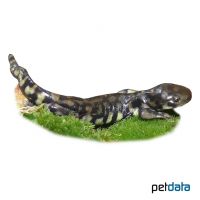Eastern Tiger Salamander (Ambystoma tigrinum)
| Eastern Tiger Salamander Ambystoma tigrinum | |
|---|---|
| Name | Eastern Tiger Salamander |
| Name Lat. | Ambystoma tigrinum |
| Family | Mole Salamanders |
| Family lat. | Ambystomatidae |
| Order | Salamanders |
| Order lat. | Caudata |
| Origin | North America |
| Habitat | Wetlands |
| Diet | Carnivore |
| Humidity | 70-90 % |
| Behavior | Semi-aggressive |
| Keeping | Individual, group |
| Care Level | Moderate |
| Breeding | Simple |
| Housing | Aquaterrarium |
| Life Span | 15-20 years |
| Protection | No |
| Metric Units | |
| Size | 35 cm |
| Temperature | 16-20 °C |
| Housing Size | 120 x 60 x 50 cm |
| US Units | |
| Size | 14" |
| Temperature | 61-68 °F |
| Housing Size | 45" x 25" x 20" |
Distribution and habitat
The predominantly crepuscular to nocturnal Tiger Tooth Salamander is widespread in North America east of the Rocky Mountains, from southern Canada to northern Mexico. They live in meadows and forests near bodies of water, from the lowlands up to 3,000 m altitude, where they spend the day hidden in burrows, some of which they have dug themselves, under stones, leaves, moss and wood.
Maintenance
The specifications are minimum dimensions for the terrarium, according to the size and number of animals:
| 1-2 animals | ground area in m²: GL x 0,01 |
The total length (GL) is measured at the largest animal. For each additional animal the floor space has to be increased by 25 %. A terrarium of L 120 x W 60 x H 50 cm is recommended, which should be placed in a quiet and vibration-free place.
They need a structured aquaterrarium with roots, flat stones and cork tubes (hiding places and visual protection), a moisture-retaining substrate, e.g. bark mulch-soil mixture with peat, leaves and moss, as well as an easy-to-clean water basin as drinking and bathing vessel. To enable digging of burrows, the substrate should be about 20 cm deep in places and about half should always be kept moist. Ficus pumila and Scindapsus, for example, are suitable for planting. Once a day, preferably in the evening, the inside of the terrarium should be finely sprayed with water (humidity), but a rain or mist system is better.
| Temp. day: 16-20 °C | Temp. night: 14-18 °C | Humidity: 70-90 |
Lighting with daylight fluorescent tubes must be 12-14 hrs, depending on the season.
Diet
The food supply should preferably consist of crickets, house crickets, grasshoppers, maggots, caterpillars, earthworms, millipedes, slugs, zophobas and mealybug larvae, supplemented with commercially available special food mixtures for insectivorous reptiles. Feeding animals should be enhanced by gifts of ripe fruits or vegetables before feeding. It is important to add minerals and vitamins regularly, e.g. by pollinating the feeders. Adult animals should be offered food daily, young animals several times a day.
A varied diet promotes health and prevents deficiency symptoms.
Reproduction and breeding
After heavy rainfall, the animals move to the spawning waters in spring. Mating and egg laying takes place in the water. The female lays up to 2,000 eggs. Depending on the subspecies, they are attached singly, in clusters, or in chains to aquatic plants or branches. The cannibal larvae hatch after 1-3 weeks and can be fed e.g. with cyclops, daphnia, artemia, mosquito larvae. After about 3 months the transformation (metamorphosis) is completed and they leave the water. Individual larvae can also overwinter and complete their metamorphosis in spring.
Important
The Tiger Toothed Salamander is the largest terrestrial salamander on the North American continent. Due to its large range, several subspecies have evolved. In some populations, the attainment of sexual maturity may occur before the completion of metamorphosis (neoteny). The picture shows an Ambystoma tigrinum mavortium (Banded Tiger Tooth Salamander) from California (USA).
Direct sunlight and temperatures above 20 °C are not tolerated in the long term. They can climb vertically on glass panes, accordingly the terrarium must be well covered.
A resting period of 2-3 months is recommended. For this, the lighting duration must be shortened by 4-6 hours and the temperature lowered to 5-10 °C, depending on the origin.
Before purchase, an aquaterrarium should be prepared that meets the species-specific needs. Necessary is good ventilation without drafts, as well as equipment for measuring temperature and humidity. Lighting has to correspond to the species-specific day-night rhythm and should be placed in such a way that the animals cannot injure themselves. The aquaterrarium should be closed in such a way that neither unauthorized persons can open it nor the animals can escape. Special attention must be paid to thorough hygiene and impurities must be removed regularly.
Further literature can be found in your pet store
References
Text: Serena Werle; Image: petdata
Source: ENGELMANN (2006): Zootierhaltung - Tiere in menschlicher Obhut: Reptilien und Amphibien, Harri Deutsch Verlag; VDA & DGHT (2006): Allgemeine Haltungsrichtlinien für Molche und Salamander
- Gemäß § 21 Abs. 5 Tierschutzgesetz idgF
